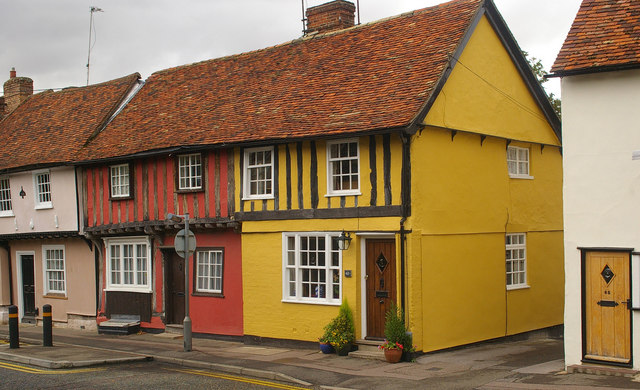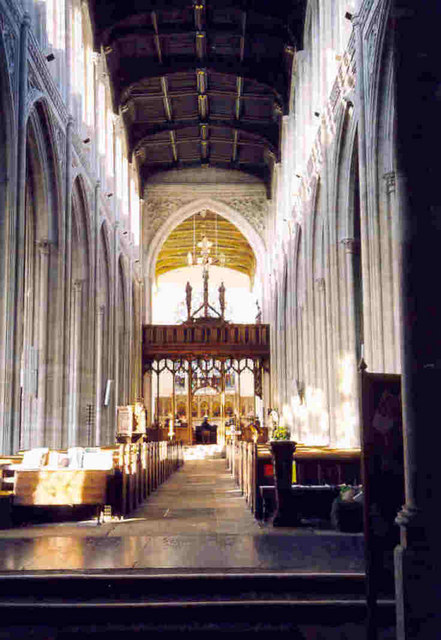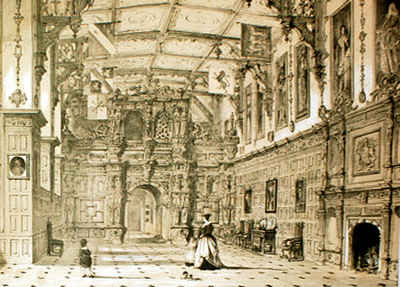|
Saffron Waldon
Saffron Walden is a market town in the Uttlesford district of Essex, England, north of Bishop's Stortford, south of Cambridge and north of London. It retains a rural appearance and some buildings of the medieval period. The population was 15,504 at the 2011 census. History Archaeological evidence suggests continuous settlement on or near the site of Saffron Walden from at least the Neolithic period. It is believed that a small Romano-British settlement and fort – possibly in the area round Abbey Lane – existed as an outpost of the much larger settlement of Cestreforda to the north. After the Norman invasion of 1066, a stone church was built. Walden Castle, dating from about 1140, may have been built on pre-existing fortifications. A priory, Walden Abbey, was founded under the patronage of Geoffrey de Mandeville, 1st Earl of Essex about 1136, on the site of what is now Audley End House. The abbey was separated from Walden by Holywell Field. After the dissolution of the ... [...More Info...] [...Related Items...] OR: [Wikipedia] [Google] [Baidu] |
St Mary The Virgin, Saffron Walden
St Mary the Virgin is the parish church of Saffron Walden, Essex. It is the largest non-cathedral church in Essex with an overall length of and the spire, high, which is the tallest in Essex. It was designated as a Grade I listed building in 1951. stmaryssaffronwalden.org, accessed 11/09/2016 A church was recorded in 1130, which in turn had replaced an earlier wooden structure. The building as it currently stands dates predominantly from a rebuilding between 1250 and 1258, with a further rebuilding in the |
Audley End House
Audley End House is a largely early 17th-century country house outside Saffron Walden, Essex, England. It is a prodigy house, known as one of the finest Jacobean houses in England. Audley End is now one-third of its original size, but is still large, with much to enjoy in its architectural features and varied collections. The house shares some similarities with Hatfield House, except that it is stone-clad as opposed to brick.Hadfield, J. (1970). ''The Shell Guide to England''. London: Michael Joseph. It is currently in the stewardship of English Heritage but long remained the family seat of the Barons Braybrooke, heirs to the estate of whom retain a portion of the contents of the house, the estate, and the right to repurchase as an incorporeal hereditament. Audley End railway station is named after the house. History Audley End was the site of Walden Abbey, a Benedictine monastery that was dissolved and granted to the Lord Chancellor Sir Thomas Audley in 1538 by Henry V ... [...More Info...] [...Related Items...] OR: [Wikipedia] [Google] [Baidu] |
John Eliot (missionary)
John Eliot ( – 21 May 1690) was a Puritan missionary to the American Indians who some called "the apostle to the Indians" and the founder of Roxbury Latin School in the Massachusetts Bay Colony in 1645. In 1660 he completed the enormous task of translating the ''Eliot Indian Bible'' into the Massachusett Indian language, producing more than two thousand completed copies. English education and Massachusetts ministry John Eliot was born in Widford, Hertfordshire, England and lived at Nazeing as a boy. He attended Jesus College, Cambridge. After college, he became assistant to Thomas Hooker at a private school in Little Baddow, Essex. After Hooker was forced to flee to the Netherlands, Eliot emigrated to Boston, Massachusetts, arranging passage as chaplain on the ship ''Lyon'' and arriving on 3 November 1631. Eliot became minister and "teaching elder" at the First Church in Roxbury. From 1637 to 1638 Eliot participated in both the civil and church trials of Anne Hutchinso ... [...More Info...] [...Related Items...] OR: [Wikipedia] [Google] [Baidu] |
Puritan
The Puritans were English Protestants in the 16th and 17th centuries who sought to purify the Church of England of Catholic Church, Roman Catholic practices, maintaining that the Church of England had not been fully reformed and should become more Protestant. Puritanism played a significant role in English history, especially during the Protectorate. Puritans were dissatisfied with the limited extent of the English Reformation and with the Church of England's toleration of certain practices associated with the Roman Catholic Church. They formed and identified with various religious groups advocating greater purity of worship and doctrine, as well as personal and corporate piety. Puritans adopted a Reformed theology, and in that sense they were Calvinists (as were many of their earlier opponents). In church polity, some advocated separation from all other established Christian denominations in favour of autonomous gathered churches. These English Dissenters, Separatist and Indepe ... [...More Info...] [...Related Items...] OR: [Wikipedia] [Google] [Baidu] |
East Anglia
East Anglia is an area in the East of England, often defined as including the counties of Norfolk, Suffolk and Cambridgeshire. The name derives from the Anglo-Saxon kingdom of the East Angles, a people whose name originated in Anglia, in what is now Northern Germany. Area Definitions of what constitutes East Anglia vary. The Anglo-Saxon Kingdom of East Anglia, established in the 6th century, originally consisted of the modern counties of Norfolk and Suffolk and expanded west into at least part of Cambridgeshire, typically the northernmost parts known as The Fens. The modern NUTS 3 statistical unit of East Anglia comprises Norfolk, Suffolk and Cambridgeshire (including the City of Peterborough unitary authority). Those three counties have formed the Roman Catholic Diocese of East Anglia since 1976, and were the subject of a possible government devolution package in 2016. Essex has sometimes been included in definitions of East Anglia, including by the London Society o ... [...More Info...] [...Related Items...] OR: [Wikipedia] [Google] [Baidu] |
Carpel
Gynoecium (; ) is most commonly used as a collective term for the parts of a flower that produce ovules and ultimately develop into the fruit and seeds. The gynoecium is the innermost whorl of a flower; it consists of (one or more) ''pistils'' and is typically surrounded by the pollen-producing reproductive organs, the stamens, collectively called the androecium. The gynoecium is often referred to as the "female" portion of the flower, although rather than directly producing female gametes (i.e. egg cells), the gynoecium produces megaspores, each of which develops into a female gametophyte which then produces egg cells. The term gynoecium is also used by botanists to refer to a cluster of archegonia and any associated modified leaves or stems present on a gametophyte shoot in mosses, liverworts, and hornworts. The corresponding terms for the male parts of those plants are clusters of antheridia within the androecium. Flowers that bear a gynoecium but no stamens are called ... [...More Info...] [...Related Items...] OR: [Wikipedia] [Google] [Baidu] |
Crocus Sativus
''Crocus sativus'', commonly known as saffron crocus or autumn crocus, is a species of flowering plant in the iris family (biology), family Iridaceae. A cormous autumn-flowering cultivated perennial plant, perennial, unknown in the wild, it is best known for the culinary use of its floral Stigma (botany), stigmas as the spice saffron. Human cultivation of saffron crocus and the trade and use of saffron have endured for more than 3,500 years and span different cultures, continents, and civilizations. Common names The plant is most commonly known as the saffron crocus. The alternative name autumn crocus is also used for species in the ''Colchicum'' genus, which are not closely related but strongly resemble the true crocuses; in particular, the superficially similar species ''Colchicum autumnale'' is sometimes even referred to as ''meadow saffron''. However, the true crocuses have three stamens and three styles, while colchicums have six stamens and one style; and belong to a diffe ... [...More Info...] [...Related Items...] OR: [Wikipedia] [Google] [Baidu] |
Crocus
''Crocus'' (; plural: crocuses or croci) is a genus of seasonal flowering plants in the family Iridaceae (iris family) comprising about 100 species of perennials growing from corms. They are low growing plants, whose flower stems remain underground, that bear relatively large white, yellow, orange or purple flowers and then become dormant after flowering. Many are cultivated for their flowers, appearing in autumn, winter, or spring. The flowers close at night and in overcast weather conditions. The crocus has been known throughout recorded history, mainly as the source of saffron. Saffron is obtained from the dried stigma of ''Crocus sativus'', an autumn-blooming species. It is valued as a spice and dyestuff, and is one of the most expensive spices in the world. Iran is the center of saffron production. Crocuses are native to woodland, scrub, and meadows from sea level to alpine tundra from the Mediterranean, through North Africa, central and southern Europe, the islands of the ... [...More Info...] [...Related Items...] OR: [Wikipedia] [Google] [Baidu] |
Saffron
Saffron () is a spice derived from the flower of ''Crocus sativus'', commonly known as the "saffron crocus". The vivid crimson stigma and styles, called threads, are collected and dried for use mainly as a seasoning and colouring agent in food. Although some doubts remain on its origin, it is believed that saffron originated in Iran. However, Greece and Mesopotamia have also been suggested as the possible region of origin of this plant. Saffron crocus slowly propagated throughout much of Eurasia and was later brought to parts of North Africa, North America, and Oceania. Saffron's taste and iodoform-like or hay-like fragrance result from the phytochemicals picrocrocin and safranal. It also contains a carotenoid pigment, crocin, which imparts a rich golden-yellow hue to dishes and textiles. Its recorded history is attested in a 7th-century BC Assyrian botanical treatise, and has been traded and used for thousands of years. In the 21st century, Iran produces some 90% of ... [...More Info...] [...Related Items...] OR: [Wikipedia] [Google] [Baidu] |
Wool-stapler
A wool-stapler is a dealer in wool. The wool-stapler buys wool from the producer, sorts and grades it, and sells it on to manufacturers. Some wool-staplers acquired significant wealth, such as Richard Chandler of Gloucester (England) who built Winston Hall in 1750. Staples "Staple" in this particular context means a market. Before the 17th century a staple was also a particular type of market, "a place appointed by royal authority, in which a body of merchants had exclusive right of purchase of certain goods destined for export". The now best known English staple was at Calais but in medieval times there were, at various times, many others throughout the kingdoms of England and Ireland and the facing coast of the Low Countries The term Low Countries, also known as the Low Lands ( nl, de Lage Landen, french: les Pays-Bas, lb, déi Niddereg Lännereien) and historically called the Netherlands ( nl, de Nederlanden), Flanders, or Belgica, is a coastal lowland region in N ... ... [...More Info...] [...Related Items...] OR: [Wikipedia] [Google] [Baidu] |
Guildhall
A guildhall, also known as a "guild hall" or "guild house", is a historical building originally used for tax collecting by municipalities or merchants in Great Britain and the Low Countries. These buildings commonly become town halls and in some cases museums while retaining their original names. Guildhalls as town hall in the United Kingdom In the United Kingdom, a guildhall is usually a town hall: in the vast majority of cases, the guildhalls have never served as the meeting place of any specific guild. A suggested etymology is from the Anglo Saxon "''gild'', or "payment"; the guildhall being where citizens came to pay their rates. The London Guildhall was established around 1120. For the Scottish municipal equivalent see tolbooth. List of guildhalls in the United Kingdom *Andover Guildhall * Barnstaple Guildhall * Bath Guildhall *Beverley Guildhall *Bewdley Guildhall *Blakeney Guildhall *Boston Guildhall * Brecon Guildhall *Bristol Guildhall *Bury St Edmunds Guildhall *Cam ... [...More Info...] [...Related Items...] OR: [Wikipedia] [Google] [Baidu] |










